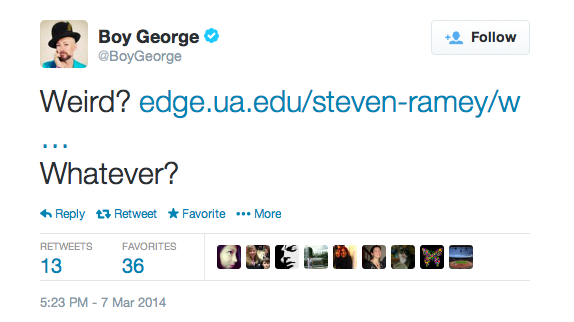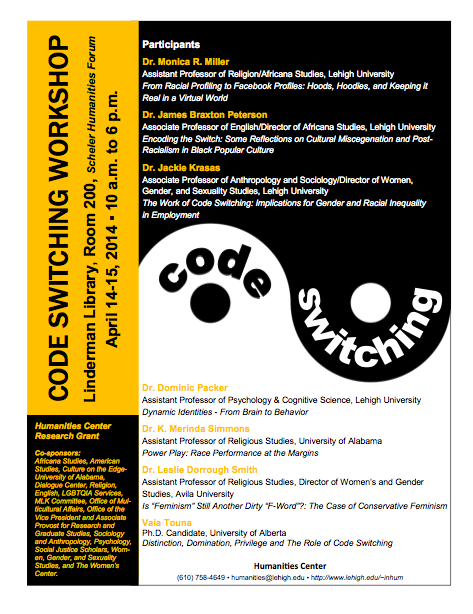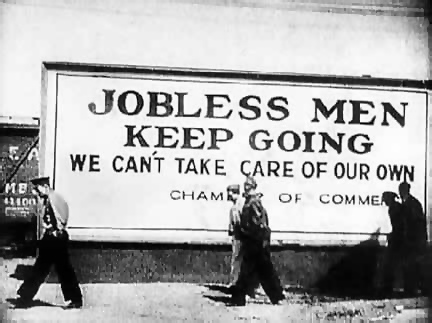 The Edge’s Merinda Simmons, pictured above (center, middle right), presents her book response at the 2014 Regional AAR, addressing notions of identity and authenticity. Learn more here… Continue reading “The Edge at the Southeastern AAR”
The Edge’s Merinda Simmons, pictured above (center, middle right), presents her book response at the 2014 Regional AAR, addressing notions of identity and authenticity. Learn more here… Continue reading “The Edge at the Southeastern AAR”
Follow the Edge @idendefying
 The Edge is now on Twitter!
The Edge is now on Twitter!
Be sure to follow us to see posts, news updates, and more from the members here at the Edge. Be sure to spread the word!
Size Doesn’t Matter
 On my way home from walking my dog I sometimes pass a house and each time I pass by it occurs to me to snap a pic. Which I finally did the other day.
On my way home from walking my dog I sometimes pass a house and each time I pass by it occurs to me to snap a pic. Which I finally did the other day.
The Edge Gets Around
 Steven Ramey’s recent post on the “multivalence of terms”—to use his words—in reference to a recent Boy George song has been making its way around
Steven Ramey’s recent post on the “multivalence of terms”—to use his words—in reference to a recent Boy George song has been making its way around
social media networks.
Click on the image to see the tweet…
Everybody Plays the Fool

When [Walter] Kirn was just starting his novel-writing career, he met a man who was a bold financier, an art collector, a fussy eccentric, a dog lover and a Rockefeller. They became friends.
But over the years Kirn began to learn that the man who called himself Clark Rockefeller was none of that — not even a dog lover. He was a psychopath and a killer.
How did Kirn fall for the fraud? Was Christian Karl Gerhartsriter — aka “Clark Rockefeller” — extraordinarily compelling? Or was the novelist, like a lot of other people drawn to the imposter, duped by his own desire to have an attachment to a famous name?
So opens a radio story on the curious case of Clark Rockefeller — or, might we say instead, the curious case of people, such as Kirn himself, who believed his friend to be the man he claimed to be. The difference between how we approach this story — is it about Rockefeller (pictured above) or Kirn? — tells us much about the social theory used to tell the tale. Continue reading “Everybody Plays the Fool”
Code Switching at Lehigh University
 On April 14-15, 2014, Lehigh University will be hosting a Code Switching Workshop inspired by, and comprised of, Culture on the Edge‘s Monica Miller, Merinda Simmons, Leslie Dorrough Smith, and Vaia Touna. They will be joined by two other Lehigh faculty members: James Peterson, Associate Professor of English and Director of Africana Studies, and Jackie Krasas, Associate Professor of Anthropology and Sociology and Director of Women, Gender and Sexuality Studies.
On April 14-15, 2014, Lehigh University will be hosting a Code Switching Workshop inspired by, and comprised of, Culture on the Edge‘s Monica Miller, Merinda Simmons, Leslie Dorrough Smith, and Vaia Touna. They will be joined by two other Lehigh faculty members: James Peterson, Associate Professor of English and Director of Africana Studies, and Jackie Krasas, Associate Professor of Anthropology and Sociology and Director of Women, Gender and Sexuality Studies.
The topic of code switching here at the Edge began last summer (2013) and then developed into a couple of blog posts (here and here).
Stay tuned to learn more
about the upcoming workshop…
Pizza Hut: The Best Indian Food Around

I had the good fortune to be able to accompany a group of my students on a short-term study abroad trip to India last year. It’s perhaps no surprise that, while there, I consumed a lot of Indian food. On the surface, that last sentence may seem rather ridiculous if only because it seems so obvious — much like saying “While in India, I saw Indian things!” But an event on our trip forced me to reconsider just how simple that observation really is, and where the parameters surrounding “authentic” and “traditional” cultural labels really lie. Continue reading “Pizza Hut: The Best Indian Food Around”
Trickle-Down Social Change?
 This is an interesting news story, for it prompts us to ask about what constitutes a social change that’s worth calling a change: opening up elite institutions to non-traditional or minority members or changing the conditions that require elite institutions in the first place? Continue reading “Trickle-Down Social Change?”
This is an interesting news story, for it prompts us to ask about what constitutes a social change that’s worth calling a change: opening up elite institutions to non-traditional or minority members or changing the conditions that require elite institutions in the first place? Continue reading “Trickle-Down Social Change?”
The Stamp of Identity
 U.S. food makers have spent a lot of money building their brands….
U.S. food makers have spent a lot of money building their brands….
In much of my work I find it useful to start with trying to understand or account for what, on first glance, seems like the easy examples, then look for increasingly messy analogical situations that can be explained in much the same fashion — a strategy that complicates the seemingly straightforward and simplifies the apparently complex. So when it comes to understanding human identity not as a public display of a self-evident, inner quality but, instead, as the naturalized result of thoroughly public contests over place and rank, maybe a good place to start is with trade disputes over making and selling cheese. Continue reading “The Stamp of Identity”
The Leading Indicators
 One of my department’s grads recently posted this story from National Public Radio, on a book that discusses the early 20th century invention of the idea of the modern economy — one that we take for granted now but which is just as imagined as any other so-called social fact. Continue reading “The Leading Indicators”
One of my department’s grads recently posted this story from National Public Radio, on a book that discusses the early 20th century invention of the idea of the modern economy — one that we take for granted now but which is just as imagined as any other so-called social fact. Continue reading “The Leading Indicators”
